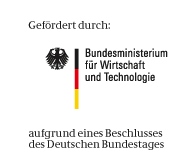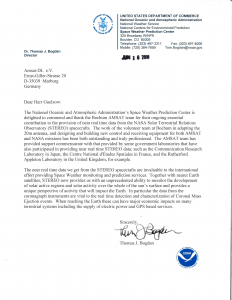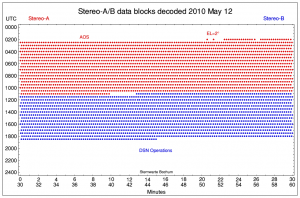AMSAT-DL is fortunate to have priority use of the 20m diameter antenna at the Bochum-Observatory, restored to working order by many volunteers in 2002-3. In early 2009 AMSAT-DL received a joint invitation from NASA and the NOAA Space Weather Prediction Center (SWPC) to partner others in downloading space weather data from the Stereo spacecraft on a “best effort” basis. This has required the development of hardware and software, remote control and dealing with the problems of keeping a system running around the clock. We considered, and find, the experience to be valuable training for advanced AMSAT operations to support other interplanetary missions to Mars.
AMSAT-DL (with funding from DLR/BMWi) is currently continuing to support the STEREO-A mission 24/7 with providing important scientific data, even after the loss of the STEREO-B spacecraft some years ago.
Why solar observing?
Effects of solar storms on the Earth:
- Auroras
- Disturbances in power grids, pipelines (induced currents)
- Impact on communications systems: Radio propagation, GNSS and communications satellites, Earth observation satellites (about 150 failures/year for U.S. satellites alone)
- Threat to manned spaceflight (especially EVAs).
Large economic damage possible. Power grid operators, satellite operators and ISS receive timely warnings from real-time data. Furthermore, the data is also used for scientific projects, including German and European Universities.
Letters from the Director of NOAA and NASA STEREO Project
We are very proud to have received these letters of appreciation for our voluntary work and continuation of our support and contributions, which already started in 2009.
STEREO Space Weather Beacon Coverage
This plot shows the real-time sources of the STEREO space weather beacon telemetry reception, including the AMSAT-DL / Bochum Radio Observatory (Amateur Station DK0SB). AMSAT-DL is also supporting DL0SHF in Kiel-Rönne and other groundstations in the STEREO network.
Here is an example image from STEREO-A received by the Bochum Radio Observatory (DK0SB) on January 15th 2012 after the data blocks have been decoded.
Current and archived STEREO images received are available online: Search for STEREO Images.

The Bochum ground station is jointly operated by AMSAT-DL and IUZ Sternwarte Bochum. We are supported by the Federal Ministry for Economic Affairs and Energy (BMWi) under project number 50OC1201. Our contribution is entirely voluntary nature of radio amateurs and space enthusiasts, without payment. The support from DLR/BMWi is mainly aimed at the maintenance of the equipment and consumption costs such as energy and lubricants, which we receive under our non-profit status.
STEREO Space Weather Beacons now using Turbo Code – Software written by AMSAT-DL
On 2nd April 2013, the two NASA STEREO space-based observatories switched to Turbo Codes to transmit their real-time space weather data permanently. A network of four ground stations, located at the IUZ in Bochum/Germany, CNES in Toulouse/France, NICT in Koganei/Japan and amateur radio station DL0SHF in Kiel-Ronne/Germany receives this data, and uses turbo-decoding software written by AMSAT-DL team members (Mario Lorenz, DL5MLO with contributions from Phil Karn, KA9Q). The software package has been made available to all STEREO Space Weather Beacon groundstations free of charge and is used world wide.
Said Doug Biesecker, NOAA Space Weather Prediction Center:
“Thanks to the wonderful work of our colleagues running the station in Bochum and the support of DLR, we can now be sure of receiving real-time data from the NASA/STEREO satellite throughout the life of the mission. The STEREO data has proven to provide significant benefits to space weather forecasting and is used by NOAA on a daily basis to ensure the best possible forecasts. Space weather increasingly threatens the technological infrastructure of our modern world, with demonstrated impacts on global positioning, power grids, and high frequency communication systems.”
The switch to Turbo Codes has improved reception capabilities of the ground stations by about 2 dB, which is a very welcome improvement giving the increasing distances – 269 and 286 million kilometers respectively – that need to be covered.
Links
- STEREO – The sun and its energetic eruptions in 3-D (DLR Space Agency)
- Stereo A/B Spacecraft Telemetry Reception at Bochum, James Miller G3RUH (2010)
- Empfang der Stereo-Raumsonden in Bochum, Hartmut Päsler DL1YDD (2012)
- Sicherstellung des Empfangs von STEREO A/B, Projektabschluss-Präsentation, Mario Lorenz DL5MLO (2017)
- STEREO Science Center, real time Beacon coverage chart (NASA)
- Search for STEREO Images received in Bochum online
- STEREO – Die Sonne und ihre energiereichen Ausbrüche in 3D (DLR)
- STEREO – ein Frühwarnsystem im All (University of Kiel)
- Receiving STEREO at the Amateur Radio Station and Radio Observatory DL0SHF in Kiel-Rönne





